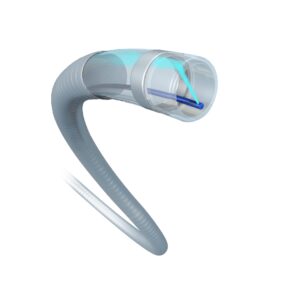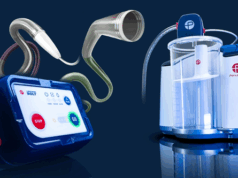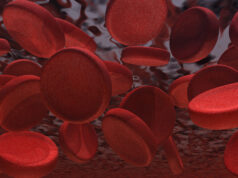
Recently presented at the Society of Interventional Radiology (SIR) annual scientific meeting (29 March–2 April, Nashville, USA), data from the Jet Enhanced Thrombectomy intervention Hydrodynamic Thrombectomy System (JETi; Abbott) registry has demonstrated the device’s effectiveness having surpassed prespecified safety and efficacy thresholds for the removal of thrombus in lower extremity deep vein thrombosis (DVT).
The JETi system is a hydromechanical aspiration system intended to remove intravascular thrombus. To evaluate its efficacy, the prospective, single-arm, all-comer, real-world venous registry was devised, enrolling 116 patients will iliofemoral DVT from 14 global sites.
Primary effectiveness was assessed by the percent of treated vessel(s) with ≥75% venous thrombus reduction from baseline to final venogram following all primary and adjunctive therapies per core lab-assessed modified Marder score. Safety was assessed by the composite rate of JETi-related major adverse events that included death, symptomatic pulmonary embolism (PE), major bleeding, and re-thrombosis of JETi-treated vessel(s) up to 30 days post procedure per clinical events committee adjudication.
Patients in this cohort had a mean age of 56.6 years, and half were female. Prior rates of DVT (21.6%) and PE (19.8%) were high in this patient population, with significant rates of other conditions such as hyperlipidaemia, diabetes and hypertension. Nearly three quarters of the population (74.1%) had onset of signs and symptoms ≤14 days, 16.4% were >14 days but ≤42 days, and the remaining (9.5%) >42 days.
The total index procedure time was reported as 124.5 minutes, while the JETi device use time was 23.5 minutes; 72.4% of patients were treated in a single session with the device. Concerning adjunctive treatments or additional interventions, 83.6% required a balloon and 55.2% a stent. Two patients required the use of the JETi HyperPulse (Abbott) thrombolytic; 13.8% of patients requiring a hand-infused thrombolytic. Catheter-directed thrombolysis was performed in 25.9% of patients—4.3% prior to JETi use and 21.6% following.
Regarding primary effectiveness, at least 75% thrombus reduction was achieved in 84.5% of treated limbs via modified Marder score, which met the prespecified performance goal of 64%. Major adverse events were reported in 1.7% of patients, including symptomatic PE and rethrombosis of JETi-treated vessels.
Patients reported improved Villalta post-thrombotic syndrome (PTS), leg pain, and quality of life scores at 30 days post procedure. Importantly, despite disclosing moderate to extremely severe pain at baseline, 81% of patients reported that they had no pain to mild pain at follow-up.
Meeting its prespecified effectiveness and safety criteria, the trial investigators highlight the marked improvement in clinical and patient-reported outcomes, and state that the registry’s one-year results which are set to be released in due course will bear out these data in greater granularity.









